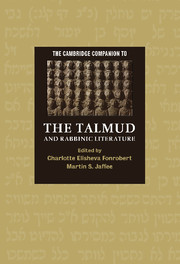Book contents
- Frontmatter
- Introduction: The Talmud, Rabbinic Literature, and Jewish Culture
- Part I: The Conditions of Rabbinic Literary Activity
- 1 Rabbinic Authorship as a Collective Enterprise
- 2 The Orality of Rabbinic Writing
- 3 Social and Institutional Settings of Rabbinic Literature
- 4 The Political Geography of Rabbinic Texts
- Part II: The Genres of Rabbinic Literary Composition
- Part III: Hermeneutical Frames for Interpreting Rabbinic Literature
- Bibliography
- Index
- Source Index
- Series List
3 - Social and Institutional Settings of Rabbinic Literature
from Part I: - The Conditions of Rabbinic Literary Activity
Published online by Cambridge University Press: 28 November 2007
- Frontmatter
- Introduction: The Talmud, Rabbinic Literature, and Jewish Culture
- Part I: The Conditions of Rabbinic Literary Activity
- 1 Rabbinic Authorship as a Collective Enterprise
- 2 The Orality of Rabbinic Writing
- 3 Social and Institutional Settings of Rabbinic Literature
- 4 The Political Geography of Rabbinic Texts
- Part II: The Genres of Rabbinic Literary Composition
- Part III: Hermeneutical Frames for Interpreting Rabbinic Literature
- Bibliography
- Index
- Source Index
- Series List
Summary
Classical rabbinic literature was produced within rabbinic educational institutions, by the sages who taught and studied there, for the purpose of educating those who attended them. This much seems clear, though unfortunately, just about all specific historical details of this process are uncertain. Until recently, the consensus of scholars regarding the nature of the rabbinic schools of Late Antiquity was anachronistic. Throughout the Gaonic Period (ca. 700-1100 c.e.), rabbis studied in academies (yeshivot), which continued to be the dominant form of rabbinic organization during the Middle Ages and to the present day. The term yeshivah indeed appears in the Mishnah and subsequent rabbinic works, and a few talmudic passages portray the rabbis in establishments that look like the Gaonic academy. Scholars therefore assumed that rabbis had founded academies in very early times, certainly in the tannaitic era and even during the Second Temple Period. However, the word yeshivah simply means “sitting” or “session,” from the root y-sh-b, “to sit.” That a rabbinic source describes the rabbis meeting in a session/ sitting (yeshivah) to study Torah does not necessarily tell us anything about the forum in which they “sat.” In principle, the rabbis could have held sessions in private homes, synagogues, courts, or anywhere they happened to be. In later times, the rabbis met in an academy, and thus the term came to refer not only to the study session but to the academy in which the session was held. But in earlier times, the nature of such sessions is an open question that can be answered only after careful study of the sources and their portrayals of rabbinic meetings.
- Type
- Chapter
- Information
- Publisher: Cambridge University PressPrint publication year: 2007
- 4
- Cited by

